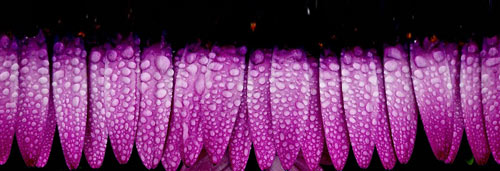kottke.org posts about Processing
Golan Levin and Kyle McDonald took some old code for converting between polar and cartesian geometries and hacked it to flatten out photos of flowers into panoramic landscapes.


Polar-to-cartesian unwrapping of flower photographs is the new flattening flowers between the pages of books. The Processing source code is available. NotCot applied the effect to chandeliers. I dorked around in Photoshop a little and you can get similar results using the “Polar Coordinates” filter…you just have to stretch out the image first. (via today and tomorrow)
The Processing Javascript library has been adapted for use on the iPhone.
iProcessing is an open programming framework to help people develop native iPhone applications using the Processing language. It is an integration of the Processing.js library and a Javascript application framework for iPhone.
Taking a bit of code from here and a snippet from there, Robert Hodgin made an animation of 3-D snakes in Processing. Check out Hodgin’s use of constraints to spur the invention of a way to keep the snakes from overlapping.
I had no interest in adding a complete 3D physics library because my needs at this time are fairly simple. I am not worried about environment… I just want the snakes to crawl over each other. I decided to try magnetic repulsion despite thinking it probably wouldn’t work well enough. The thinking is this: Take each segment of a snake (200 segments each), and check its distance to every single other segment of every other snake on screen. Stupid, right? Yeah, pretty much. But with some optimization and only checking the segment distances if the snakes in question are close enough for overlap to be possible, I got it to run at 60 fps with 10 snakes.
Actually, when you get right down to it — the atoms in snakes’ bodies, that is — magnetic repulsion isn’t that far off from how matter achieves its electromagnetic opacity. Hodgin also made a video in which the snakes react to music. I wonder if this one’s gonna end up in iTunes. (via waxy)
The Processing programming language/environment goes 1.0. From the press release:
What is new in Processing 1.0?
The most important aspect of this release is its stability. However, we have added many new features during the last few months. They include a new optimized 2D graphics engine, better integration for working with vector files, and the ability to write tools to enhance the development environment.
Download the newest version here. (thx, dan)
Update: Ben Fry has the press release.
A British company called Faber & Faber is doing print on demand books with a wrinkle: each book has its own distinct cover that’s generated at print time.
Generating the borders was just one, if major, task of the final solution, though. The custom software written in Processing, straight Java and PHP works as an internal webservice at Faber which receives new batch orders and then generates complete, print ready PDF files with all copy, branding, spine, ISBN, barcode and optional high-res JPG preview using the book details supplied. Generating a single cover only takes about 1 second, but due to its iterative and semi-random nature can sometime require hundreds of attempts until a “valid” design is created which is judged to be “on brand” by software itself.
What a day it will be when software can determine whether all of us are “on brand” or not. (thx, david)
Casey Reas and Ben Fry, inventors of the Processing programming language (that’s Proce55ing to you old schoolers), have just come out with a book on the topic that looks fantastic. In addition to programming tutorials are essays and interviews with other heavy hitters in the programmatic arts like Golan Levin, Alex Galloway, Auriea Harvey, and Jared Tarbell. The site for the book features a table of contents, sample chapters, and every single code example in the book, freely available for download. Amazon’s got the book but they’re saying it’s 4-6 weeks for delivery so I suggest hoofing it over to your local bookstore for a look-see instead.
Syllabus and notes from an ITP class called The Nature of Code, which focuses on “the programming strategies and techniques behind computer simulations of natural systems”. Lots of good notes and Processing code examples.
Processing applet in which an adaptive population plays tag. “If a member plays tag well (when they’re it, they tag others), they’ll live longer.” Prettiest game of tag I’ve ever seen. (via proc blogs where you’ll find lots of neat Processing-related things)
The letter-pairs analysis application reads in some text and displays a graphical representation of distribution of letter pairs used in the text. Love the aesthetics of the information display.







Stay Connected